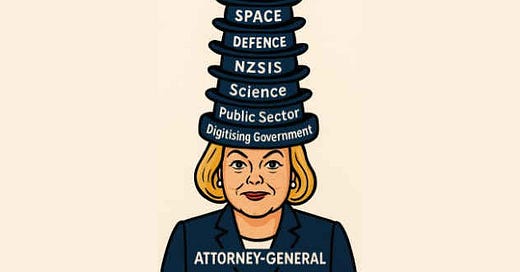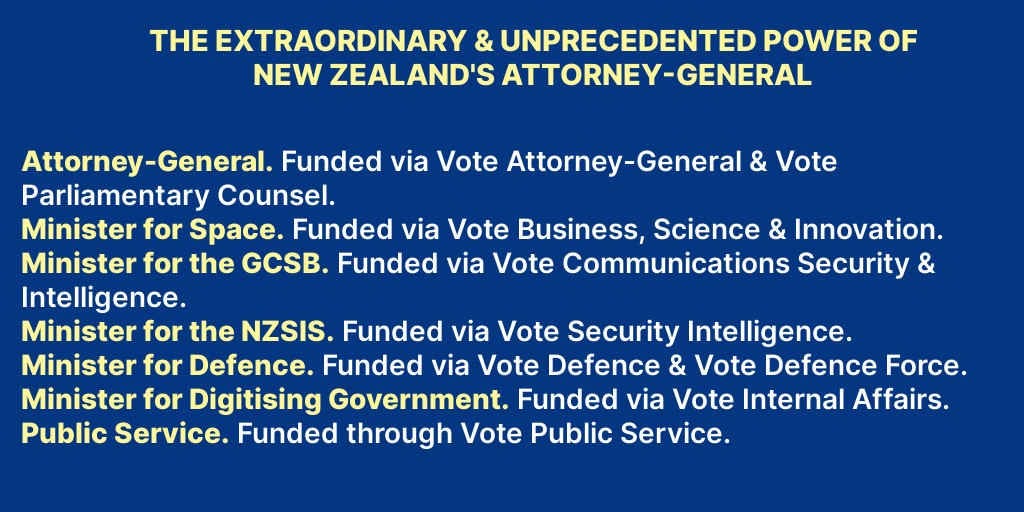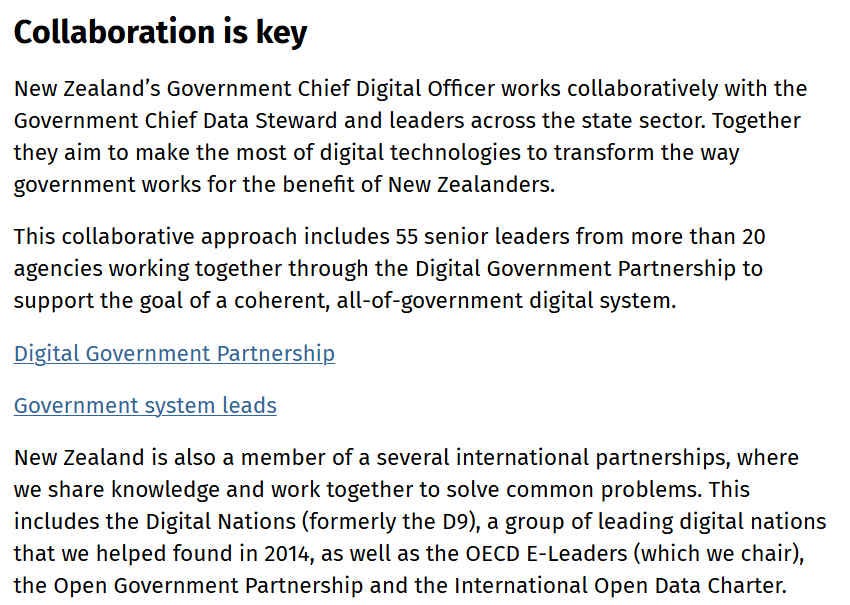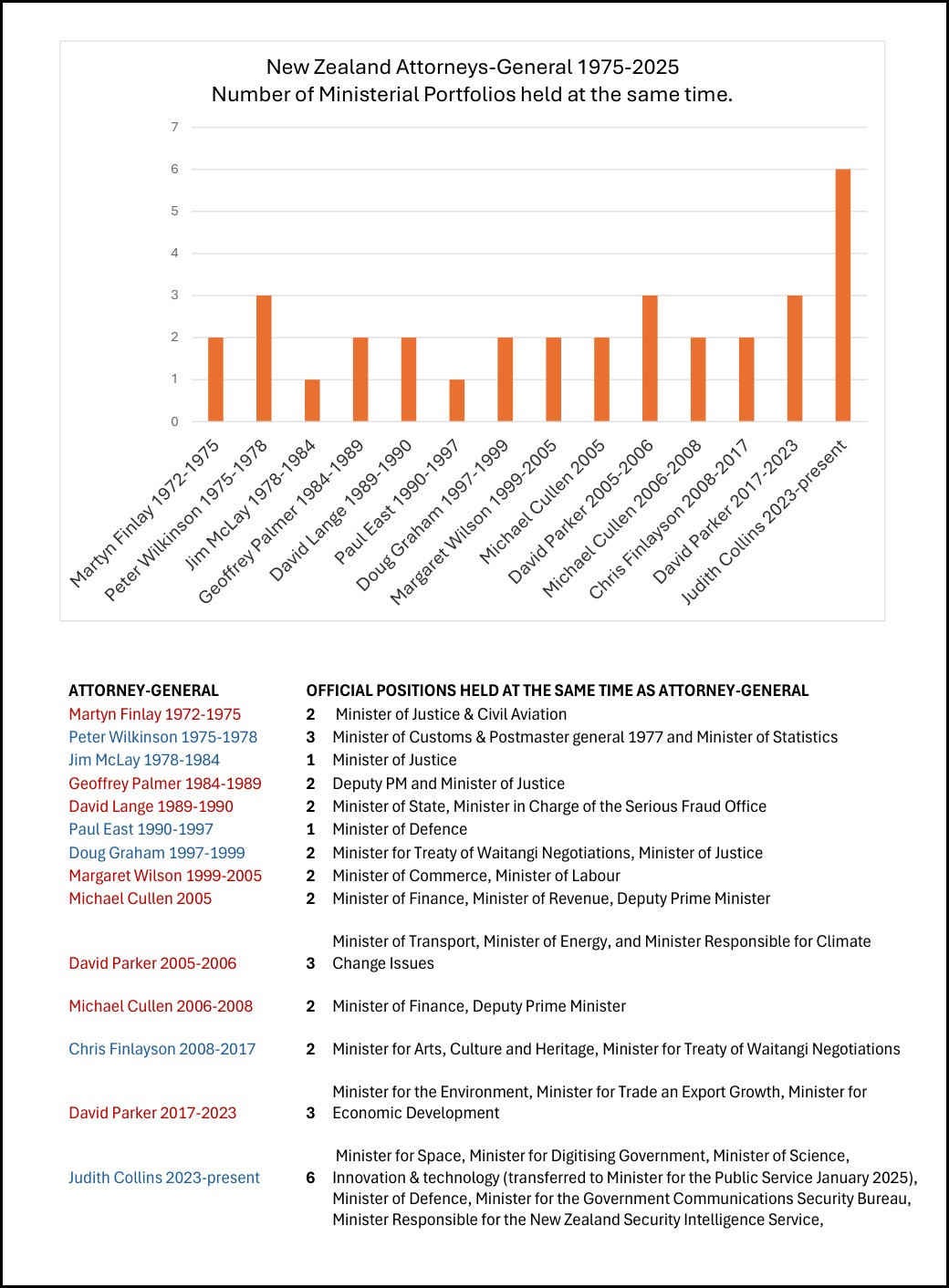Has New Zealand’s Attorney-General got too much power?
New Zealand’s Attorney-General Hon Judith Collins has secured the responsibility for six ministerial hats, rather than the conventional two, or perhaps three hats.
Published June 3, 2025, on New Zealand’s Daily Telegraph. Here is an extract - or feel free to jump straight to the original article.
I keep waiting for a prominent journalist, or public law expert to query this concentration of power, but crickets.
The Attorney-General Hon Judith Collins has not wasted time since National came to power in 2023. Collins moved swiftly to lock in policies to reform the science system and genetically modified organisms (GMO) regulation.
Collins is the Minister for the Government Communications Security Bureau (GCSB); the Minister for Space; the Minister for Defence; and the Minister for the New Zealand Security Intelligence Service (NZSIS). Early this year, just weeks after finishing the science system overhaul and sending the Gene Technology Bill to select committee, the Hon Judith Collins swapped her science minister hat to become the Minister for New Zealand’s Public Service.
Within a couple of months Collins announced that she was overhauling the 2020 Public Sector Act. Collins is now aiming to:
Really? A five-year-old Act is already out of date? Is this the opinion of many, or just whirlwind Collins? Some picturesque resources have been produced, but there do not seem to be wholesale calls to overhaul this Act. What is happening here?
As the Minister for Digitising Government, Collins is acutely aware that ‘It’s a portfolio that goes hand in glove with the public service.’
In 2016 Otago professor of Law Andrew Geddis remarked that the system was working and that ‘New Zealand has managed to combine unified and intensive forms of public power with a genuinely free and open society’ noting that New Zealand:
‘hardly has plunged the nation into a nightmarish vista of totalitarian authoritarianism, ruled over by the fiat of a handful of individuals in central government.’
Where are we ten years later, after a pandemic that required 13-year-olds to be vaccinated with a novel gene technology that never promised to prevent hospitalisation and death, in order to attend sporting events? Where are we ten years later, watching the Attorney-General oversee legislation that demonstrably lacks scientific credibility, before pivoting swiftly to work on breaking open the Public Sector Act, while she strengthens digital government and controls the NZSIS, GCSB and the Defence budget?
Collins strategic position is all the more startling because of the capacity for digital scaling and oversight by relatively small numbers of individuals, using secretive, black-boxed technologies that remain out-of-sight of the public.
This concentration of powers appears to be metamorphizing at the very time that Kiwis are becoming poorer and sicker.
SCALING UP EXECUTIVE OVERSIGHT POWERS
New Zealand’s executive government is charging full-tilt into maximising the opportunities provided by the scalar potential of digital and surveillance technologies. No – New Zealand doesn’t have a high rate of fraud which would entail increased ID security measures:
‘New Zealand has the lowest fraud rate of our partner countries (Australia, Canada, United States of America, United Kingdom and Ireland. For 2023, 11 cases of fraud were detected, representing 0.0023% of the 472,872 passports issued.’
There is no real reason to compulsorily require a Digital ID to access jobs, services and resourcing. It’s a political decision.
Much of the herding, or corralling onto Digital ID tech through a series of policy nudges is all ‘voluntary’. You don’t have to get a digital ID if you don’t want one. However, life can get inconvenient. The policy nudges are undertaken in full awareness that as a social species, we will comply.
Without a digital ID there are barriers to government jobs and specific services, such as arbitration services or government funding grants. A digital ID is compulsory for a gun licence. It may not be compulsory to access tertiary education, but if you have one, it’s much easier to slip into the tertiary system.
Then there is the quiet work by StatsNZ on a statistical register, called the Integrated Statistical Data System. StatsNZ’s plans for a unique identifier for every New Zealander should be unthinkable for anyone keen on limiting administrative over-reach.
Journalist Bonnie Flaws, who used to work for the accredited media, has recently published a four-part report, on how StatsNZ would have oversight and access to a massive real-time database where all kiwis have a unique digital tag. She’s outlined how the relatively unknown system has potential to accumulate fine-grained information on every individual, how privacy and data matching is a real problem, how this work extends way beyond the normal production of statistics, involving extensive access to a proliferation of data streams, and how the 2028 Census will become yet another contraction point for the merging of private data into a centralised database.
Most people are unaware of the secretive approved information sharing agreements (ASIAs) between our government agencies. The department tasked with formulating trust in digital identity services in New Zealand, the Department of Internal Affairs (DIA), is pretty much accountable to itself. The Privacy Commissioner doesn’t stand a chance.
The latest ‘oops, you’ll need an ID for this’, is a members bill to ‘protect’ under 16s through bans to designated social media platforms. Incidentally, the technicalities would necessarily entail proof of ID by everyone. It’s yet another example of a policy that harmonises with other Anglo nations, where policies consistently grant the government even greater powers of oversight.
Most recently Collins, with tourism Minister Louise Upton, released an App for tourists that ‘signals step toward modern digital identity system’. Necessarily, the App, which is currently only marketed for tourism purposes as a convenience to prove a foreign driver’s license, will be tied to revocation lists. Last year the App for a digital New Zealand driver’s license was released.
In a time of increasing opacity – please understand that revocation lists can be configured en masse.
Flaw’s work adds to PSGR’s 2024 research, which showed how central bank digital currencies (CBDCs) would necessarily be interoperable and toggled to your own digital ID. The extent to which orders can be sent from a distance and impact groups of people should be alarming to anyone who appreciates how swiftly emergency powers can be put in place in this country.
CBDC are a technocrat’s dream. Three-party locks can be programmed whereby a third party could specify functionality. Several actions can be bundled into one executable package (referred to as ‘composability’). In human language, discrete instructions could come from an unknown (but internally verified) source, identifying and tagging groups for the same action. Bank accounts of not just an individual, but groups of people could be frozen, or CBDCs withdrawn.
CBDCs may or may not come into force, but we’re watching governments freeze bank accounts with increasing impunity.
Make no mistake, digital IDs, biometric camera data and the related technologies are enabling governments to have much greater powers of oversight over us. By comparison, there has been no commensurate scaling up of oversight powers over the agencies who will hold the access to the technologies and our private information, and therefore the oversight over us.
We now have generations of government officials who are schooled in the merits and culture of ‘innovation’, ‘efficiency’ and cost cutting. But were they ever schooled on constitutional and administrative law?
Collins intends to embrace innovation in her public sector overhaul work. If you are a regular reader of my Op Eds, you might recognise the buzzword ‘innovation’. It’s a signal that more tech will be integrated into system frameworks.
Alas, innovation has nothing to do with transparency and accountability, and everything to do with efficiency. We can speculate that ‘innovation’ is a signal that operative capacity and service delivery will be enhanced. This will most likely involve the scaling up and integration of technologies that effectively and inevitably concentrate power.
When it comes to digital government which overlaps neatly with the public sector portfolio, and surveillance and intelligence portfolios, collaboration is key.
WHEN POWER CONVERGES IN ONE PERSON
The Attorney-General is powerful and influential. As Professor Philip Joseph has succinctly outlined, the Attorney General (A-G) is the senior law officer, the ‘channel of communication between the Judiciary and the Government’. Right. That’s a lot of power.
Let’s start by drawing from the biblical in proportion Joseph on Constitutional and Administrative Law tome, to highlight the powers of the Attorney-General. The Attorney-General (A-G) is both the senior law officer and a cabinet minister discharging portfolio responsibilities, the ‘channel of communication between the Judiciary and the Government’. Public Law expert Professor Philip Joseph explains:
‘The Attorney-General has four primary areas of responsibility. These involve the roles of senior law officer of the Crown, principal legal adviser to the government, named plaintiff/defendant representing the Crown in litigation by or against the government, and liaison and link between the government and the judiciary.
The Attorney-General must act always in the public interest. The senior law officer stands in a special relationship with Parliament, the courts and the executive,’ [1]
As well as holding six Ministerial portfolios, the A-G holds a unique position in Cabinet:
‘as senior law officer, the Attorney occupies a special relationship to his or her cabinet colleagues. By convention, the Attorney must exercise independent and impartial judgment, without exception for party political considerations or policy goals. The Attorney’s law officer decisions are exempt from collective cabinet responsibility and cannot be overridden by Cabinet’s collective will.’ [2]
The A-G also represents the Crown when ‘rights of a public character’ are raised:
‘The Attorney discharges this role in any of three ways: by bringing actions in the Attorney’s capacity to enforce public rights, by authorising relator proceedings to enforce public rights, or by intervening in private litigation to protect the public interest… The Attorney may intervene, upon invitation or with leave of the court, where a private action might affect the prerogatives of the Crown or raise questions of public policy.’ [3]
As part of A-G powers, the A-G has the responsibility to select judges.
In the past 50 years New Zealand Attorneys-General have had two, perhaps three ministerial portfolios. The Hon Judith Collins, KC, has six, and they strategically overlap. That is tremendous centralisation of power.
It is not normal for an Attorney-General (A-G) to hold six ministerial portfolios
By contrast, in the United Kingdom, for example the Rt Hon Lord Hermer KC is the Attorney General (A-G) for England and Wales. The UK A-G for England and Wales is not an elected member of Parliament and does not hold ministerial positions. The UK A-G is a member of the Privy Council and the National Security Council and attends, but is not a member of Cabinet. As Attorney General, Hermer also holds the position of Advocate General for Scotland.
In Australia, the A-G, the Hon Michelle Rowland is an elected member of Parliament. Rowland is also the Minister for Communications.
The A-G for Northern Ireland is Dame Brenda King. King is not a politician and does not hold ministerial portfolios. The A-Gs for Singapore, Sri Lanka, Malaysia, India are not a politician.
In Canada, the Hon Sean Fraser holds the position of A-G. At only 40, Fraser has three ministerial positions, Minister for the Atlantic Canada Opportunities Agency, Minister of Housing, Infrastructure and Communities and Minister of Immigration, Refugees and Citizenship. Fraser is also Parliamentary Secretary to the Minister of Finance, the Minister of Middle Class Prosperity and the Minister of Environment and Climate Change. Parliamentary secretary positions are directly appointed by Canada’s Prime Minister. The role is a liaison role between a Minister and Parliament and viewed as a training ground for future advance.
Our A-G outpaces them all.
CABINET HEGEMONY & THE SEPARATION OF POWERS
To continue reading:








That there is one powerful minister for security, intelligence science and law- infers that the powers-that-be require a deliberate fasttrack for streamlined decision-making in the event of threats of resistance to the UN mandated biotech-pharma-military-industrial-terrorism complex. The introduction of biometric digital ID solves all ills- one Login to access your legal-tender stablecoin, your vaccine-health status, your compulsory curriculum, your programmed govt benefit, your carbon taxes, and your thought-criminal record. One minister to rule them all and one minister to bind them. And the AG is autonomous. Technocratic optics absolutely. Thanks JR, alarming prospects of power concentration.